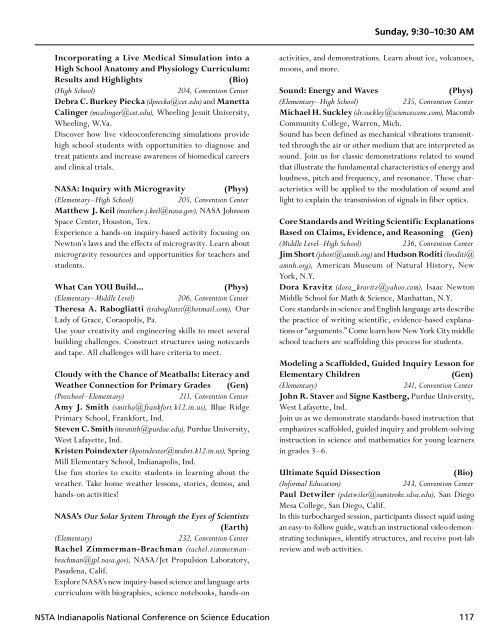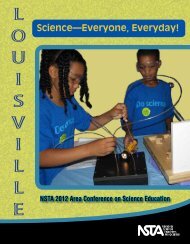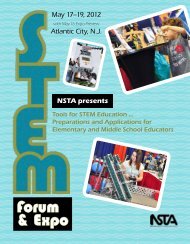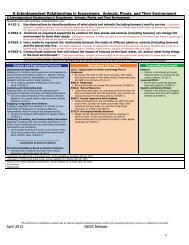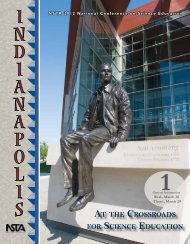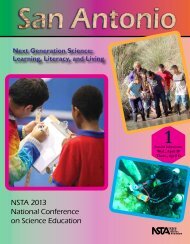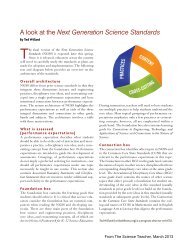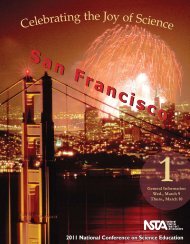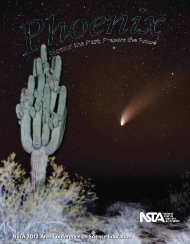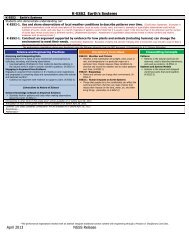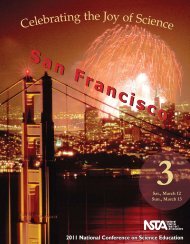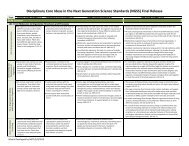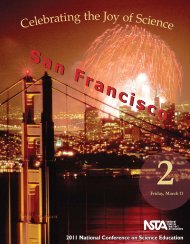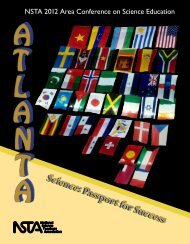Saturday/Sunday
Saturday/Sunday
Saturday/Sunday
Create successful ePaper yourself
Turn your PDF publications into a flip-book with our unique Google optimized e-Paper software.
<strong>Sunday</strong>, 9:30–10:30 AM<br />
Incorporating a Live Medical Simulation into a<br />
High School Anatomy and Physiology Curriculum:<br />
Results and Highlights<br />
(Bio)<br />
(High School)<br />
204, Convention Center<br />
Debra C. Burkey Piecka (dpiecka@cet.edu) and Manetta<br />
Calinger (mcalinger@cet.edu), Wheeling Jesuit University,<br />
Wheeling, W.Va.<br />
Discover how live videoconferencing simulations provide<br />
high school students with opportunities to diagnose and<br />
treat patients and increase awareness of biomedical careers<br />
and clinical trials.<br />
NASA: Inquiry with Microgravity (Phys)<br />
(Elementary–High School)<br />
205, Convention Center<br />
Matthew J. Keil (matthew.j.keil@nasa.gov), NASA Johnson<br />
Space Center, Houston, Tex.<br />
Experience a hands-on inquiry-based activity focusing on<br />
Newton’s laws and the effects of microgravity. Learn about<br />
microgravity resources and opportunities for teachers and<br />
students.<br />
What Can YOU Build...<br />
(Phys)<br />
(Elementary–Middle Level)<br />
206, Convention Center<br />
Theresa A. Rabogliatti (trabogliatti@hotmail.com), Our<br />
Lady of Grace, Coraopolis, Pa.<br />
Use your creativity and engineering skills to meet several<br />
building challenges. Construct structures using notecards<br />
and tape. All challenges will have criteria to meet.<br />
Cloudy with the Chance of Meatballs: Literacy and<br />
Weather Connection for Primary Grades (Gen)<br />
(Preschool–Elementary)<br />
211, Convention Center<br />
Amy J. Smith (smitha@frankfort.k12.in.us), Blue Ridge<br />
Primary School, Frankfort, Ind.<br />
Steven C. Smith (mrsmith@purdue.edu), Purdue University,<br />
West Lafayette, Ind.<br />
Kristen Poindexter (kpoindexter@msdwt.k12.in.us), Spring<br />
Mill Elementary School, Indianapolis, Ind.<br />
Use fun stories to excite students in learning about the<br />
weather. Take home weather lessons, stories, demos, and<br />
hands-on activities!<br />
NASA’s Our Solar System Through the Eyes of Scientists<br />
(Earth)<br />
(Elementary)<br />
232, Convention Center<br />
Rachel Zimmerman-Brachman (rachel.zimmermanbrachman@jpl.nasa.gov),<br />
NASA/Jet Propulsion Laboratory,<br />
Pasadena, Calif.<br />
Explore NASA’s new inquiry-based science and language arts<br />
curriculum with biographies, science notebooks, hands-on<br />
NSTA Indianapolis National Conference on Science Education<br />
activities, and demonstrations. Learn about ice, volcanoes,<br />
moons, and more.<br />
Sound: Energy and Waves<br />
(Phys)<br />
(Elementary–High School)<br />
235, Convention Center<br />
Michael H. Suckley (dr.suckley@sciencescene.com), Macomb<br />
Community College, Warren, Mich.<br />
Sound has been defined as mechanical vibrations transmitted<br />
through the air or other medium that are interpreted as<br />
sound. Join us for classic demonstrations related to sound<br />
that illustrate the fundamental characteristics of energy and<br />
loudness, pitch and frequency, and resonance. These characteristics<br />
will be applied to the modulation of sound and<br />
light to explain the transmission of signals in fiber optics.<br />
Core Standards and Writing Scientific Explanations<br />
Based on Claims, Evidence, and Reasoning (Gen)<br />
(Middle Level–High School) 236, Convention Center<br />
Jim Short (jshort@amnh.org) and Hudson Roditi (hroditi@<br />
amnh.org), American Museum of Natural History, New<br />
York, N.Y.<br />
Dora Kravitz (dora_kravitz@yahoo.com), Isaac Newton<br />
Middle School for Math & Science, Manhattan, N.Y.<br />
Core standards in science and English language arts describe<br />
the practice of writing scientific, evidence-based explanations<br />
or “arguments.” Come learn how New York City middle<br />
school teachers are scaffolding this process for students.<br />
Modeling a Scaffolded, Guided Inquiry Lesson for<br />
Elementary Children<br />
(Gen)<br />
(Elementary)<br />
241, Convention Center<br />
John R. Staver and Signe Kastberg, Purdue University,<br />
West Lafayette, Ind.<br />
Join us as we demonstrate standards-based instruction that<br />
emphasizes scaffolded, guided inquiry and problem-solving<br />
instruction in science and mathematics for young learners<br />
in grades 3–6.<br />
Ultimate Squid Dissection<br />
(Bio)<br />
(Informal Education)<br />
243, Convention Center<br />
Paul Detwiler (pdetwiler@sunstroke.sdsu.edu), San Diego<br />
Mesa College, San Diego, Calif.<br />
In this turbocharged session, participants dissect squid using<br />
an easy-to-follow guide, watch an instructional video demonstrating<br />
techniques, identify structures, and receive post-lab<br />
review and web activities.<br />
117


